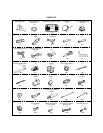
CAUTION ! ATTACH THE CRUISE CONTROL CABLE SO THAT IT PARALLELS THE EXISTING THROTTLE CABLE AS
NEARLY AS POSSIBLE.
WARNING ! AFTER ATTACHING THE CRUISE CONTROL CABLE TO THE VEHICLE’S THROTTLE, OPERATE THE
THROTTLE MANUALLY ( FULL TRAVEL ) FROM BOTH UNDER HOOD AND ACCELERATOR PEDAL TO BE
ABSOLUTELY SURE THAT NONE OF THE CABLE ATTACHMENT COMPONENTS OR BEAD CHAIN CAN
RESTRICT OR INTERFERE WITH THE NORMAL THROTTLE OPERATION.
Mounting the Servo Assembly
1. Plug the 10 pin connector from the main harness into the mating connector on the servo assembly, arrange
the wires so that they do not cross over one another, and replace the plastic cover with the ( 2 ) screws
previously removed.
2. A) When selecting the location for the servo, make sure that the cable routing follows a smooth path, with
no sharp bends. You must also be sure that the cable is routed away from any hot, sharp, or moving
components within the engine compartment.
B) This unit has rapid response valves inside the servo which constantly operate during cruise operation.
To prevent noise transferring to inside the passenger compartment we strongly recommend this unit NOT
be mounted to the fire wall.
3. Using ( 2 ) of the M6 x 3/4" long hex washer head sheet metal screws, mount the servo to the selected location.
Do Not mount servo on the engine !
4. Attach the eyelet terminal on the end of the Black wire to a solid chassis ground bolt within the engine
compartment.
Connecting the Vacuum Hose
1. Plug the vacuum hose onto the servo assembly.
2. Route the vacuum hose to an existing vacuum hose that has constant vacuum while the engine is running
at idle, trim the hose to length, and make the attachment using the appropriate size T connector from the
kit.
See Diagrams below for common vacuum source connection.
Tube Vacuum
Tee-Tube
Vacuum Line
Tube Vacuum
Reducer-Tube
Existing Vacuum Line
Factory Installed Tee
Remove cap and use
Vacuum Tee for Cruise
Control vacuum
Manifold Vacuum Tree
Remove cap and
use vacuum port
for Cruise Control
vacuum
WARNING ! NEVER CUT OR ATTACH TO THE POWER BRAKE BOOSTER VACUUM HOSE.
Vacuum Test
Look for the vacuum hose coming directly from the intake manifold.
Run the engine at idle, and place your finger over the selected vacuum source. You should feel a strong suction
on your finger. Remove your finger and a noticeable change in engine RPM or engine smoothness should
result. Note: This vacuum source must maintain at least a minimum of 6 inches of mercury vacuum. If the
vacuum is lower than 6 inches while the pedal is depressed, then a vacuum canister must be used.
-6-


















